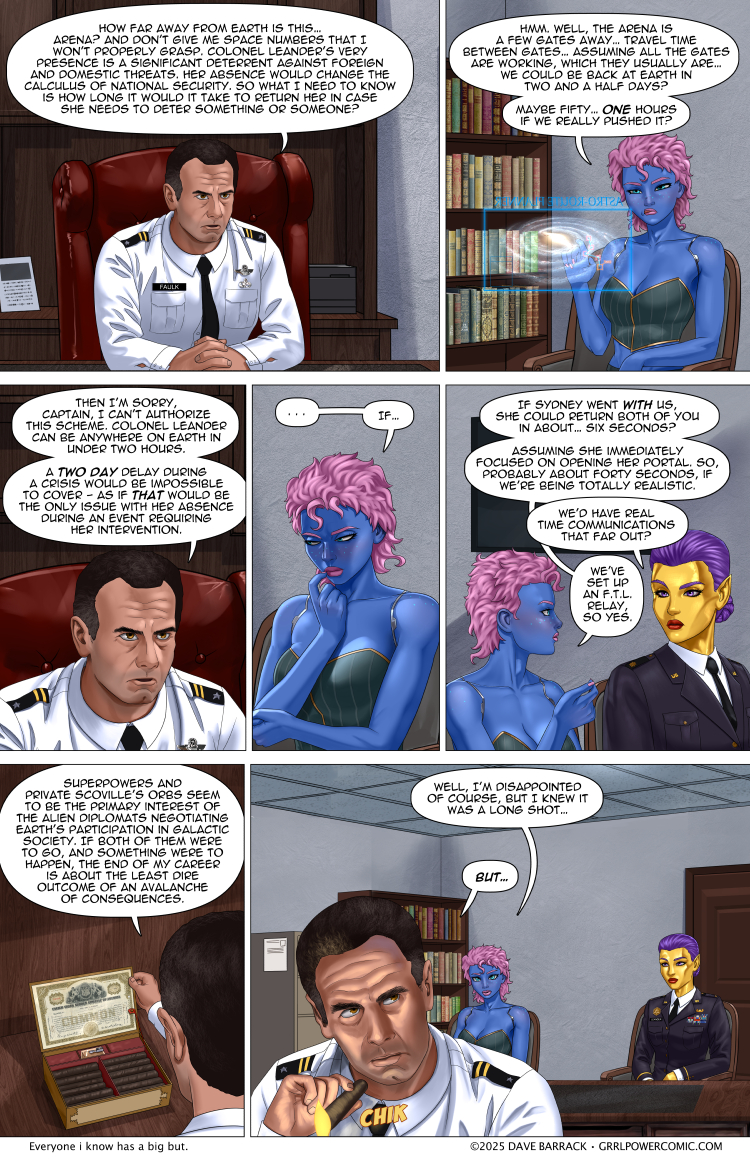Grrl Power #1370 – Definitely no but maybe
“But…” You have a spaceship and we want to continue to have access to a spaceship, so…
That’s the real subtext of whatever Faulk is going to say on the next page. “Please let us continue to use your stuff which would take Earth 200 years* of concerted effort otherwise. Also your incredible medical technology and space pornography.” Like I said, subtext.
It’s still a bad idea for a lot of reasons. Throwing Sydney into the mix does offer a solution to the biggest problem, but still adds to the list of bad things that can go badly if something bad happens.
The first time Sydney found herself out amongst the general galactic population, nobody knew her orbs were significant. On a station where you can buy holographic wings, floating glowy things hardly stand out. But now it’s known that her orbs are known about. Sure, people claim to find Nth tech all the time, but the payoff if it’s real is enough for alien governments and other organizations to take interest in rumors and potential scams.
* Predicting what technology will look like in the future is something that most people are really bad at. I hate it when movies show some futuristic cityscape with flying cars and the info-text pops up and says “In the amazing year 2019!” Seriously, Blade Runner with humanoid… bioroids (?) and flying cars and pyramidal buildings 16 square blocks at the base, takes place in 2019. I mean, the movie was made in 1982, but that’s still only 37 years to transform entire city skylines, invent flying cars, and oh, Roy said something about seeing “Attack ships on fire off the shoulder of Orion…” If he was being literal, then the stars that form the constellation Orion’s shoulders are Bellatrix, which is 250 light years away, or Betelgeuse, which is… uh… hard to measure for reasons, and is between 400 and 550 light years away. Which means within 37 years of the movie coming out, when the pinnacle of home computing power was the Commodore 64 or the Apple IIe, (both of which had CPUs that ran at 1.023 MHz, BTW) the writers thought we’d invent some pretty fucking impressive warp travel.
Unless they wanted someone who was alive when the movie came out to appear as an older person in the movie, like some expository news cast saying “Bill Gates turned 73 today…” or something like that, there is NO REASON not to say that movie takes place in 2119. No one seeing that movie in the theater would be alive in 2119 to complain about it like I am now.
My point here is, could Earth make a warp capable spaceship in 200 years? Who the hell knows? Obviously it depends on if warp travel is even possible and what is required to achieve it. If you need to set up an orbital facility in low orbit of a neutron star in order to produce FTL-onium, then it might take us 4,000 years to make the first one, because it’ll take a long ass time to build that first factory. (Apparently the closest neutron star is 400 light years away, so it would actually probably take closer to 40,000 years to get there with conventional propulsion.) On the other hand, if you just need a shitload of energy to throw at the problem and that lets you Alcubierre the problem, then… maybe? Honestly, the rest of the ship isn’t so challenging. Once you have enough energy to not have to worry about barely being able to lift your own fuel into space with you, then you could make something that looked like a cool space ship covered in armor instead of all of our space stuff now, which looks like tinker toys covered in foil and quilted blankets.
So in the Grrl-verse, with Earth’s supers, yeah, you could probably build everything but the warp drive on Earth and have someone like Maxima carry it into space. Or have her carry a bunch of shit into space to be assembled as a factory, which would put together components or whatever. The superpowers will give Earth a massive timetable advantage when it comes to spacetravel. Getting warp engines will probably still be expensive though.
 The vote incentive is finally done!
The vote incentive is finally done!
The update to the TWC image is pretty minor, but the Patreon version has the bonus comic as well as nude versions. I will strive to make the next one more timely.
Double res version will be posted over at Patreon. Feel free to contribute as much as you like.
















Cue life extension tech making a living memory in 2119 possible.
But only if you have a spare few million lying around.
But cool mech fights… I mean we would be able to make an accurate comparison of our defensive capabilities against extra terrestrial threats.
cue interstellar foreign relations tournament in the milky way?
Sydney is mostly known by the orbs floating over her head rather than her actual appearance. So the easy solution is for Cora and Dabbler to come up with some look-alike high-tech floaty orbs and sell them on Arenaworld in advance of Max and Sydney going there.
You could likely cobble together floaty orb kid toys/fashion statements fairly inexpensively then sell them close to cost to make sure they make it out into the public.
Maybe a small advertising campaign for Floaty Orbs to make sure everyone knows they exist.
No one is going after Sydney or her orbs if they think she’s one of thousands of people who have toys floating around her head.
Arianna’s three favourite words: Collect Them All!
That is, indeed, a really good idea.
Make dozens of designs, and disguise hers as one of them, so that others look more like Halo’s than hers do.
Did he just let slip Maximas too speed? Anywhere on earth in under two hours would mean at least 12,500 ish miles per hour? Roughly 20,000 kmh.
That’s assuming she’s flying at relatively low altitude, harder to determine exactly since we don’t know exactly how high she generally flies at, and this is all assuming she’s not able to just fly down through the ground in a straight line (I don’t think she could do that, if only because her clothes wouldn’t survive) which would be pretty insane.
Of course he could be lying, but it’s unlikely he would intentionally oversell her abilities to an ally, more likely he would undersell what she could do…
You’re twice as fast. The earth is 25k miles around. So, no point is more then 12.5k miles away, two hours is 6,250 mph, which is about Mach 9 at best, and we know she can move faster than that.
I will say it was strangely perfectly reasonable for people through much of the 1900s to assume some crazy advancements would be made in a matter of decades…maybe not to the point of redesigning entire skylines like Blade Runner, but various robotics, cyberpunk, space exploration, yeah, because the world they lived in was one of constant invention. Each decade, just every few years something was coming out that was seen as “the greatest it could be, the future for the next hundred years of this technology” only for a better version to come out like three years later. Video games between 1970s to 1990s went from Pong to Mortal Kombat. A person 70 years old in 1969 to see the Moon landing, grew up in a world where motor vehicles became standardized, the motion picture went from talkies and a sideshow when they were a toddler, to theater in every town, to televisions in most homes, they saw the radio show be replaced, they even saw these tv shows go into color. They saw the early stages of robotics, they saw electricity and the everyday homes having plumbing…the baby boomer era of focus on the nuclear family was a major push for this sort of thing…they lived from first flight to landing on the moon in their life time.
So if a tv program talked about teleportation, or astronauts talking to Venusian space babes and planet X invasions, they’d not think it all that strange, scientists and mostly companies were even promising this stuff, yeah the whole robot in every home helper thing…you can see car companies making commercials for this way back…heck the home of tomorrow was a huge push…oddly a lot of appliances just to give this “we are progressing into the Jetsons” kind of vibe put in a lot of extra features…including some I know plenty of people today probably wish they still had in cabinets and fridges and what not. So yeah, when a movie was talking about super intelligent robots they were looking at science magazines talking about neural computers and thinking AI was just around the corner and super intelligent machines, they saw new space discoveries all the time and figured we would be going to Mars by the end of the 80s (I mean the average person doesn’t realize how much further that really is than the moon and harder to get right and everything), but that was the atmosphere of much of the 20th century.
its just the last few decades, 2000 and on, while there have been plenty of discoveries and changes, they haven’t been AS noticeably extreme alterations to what was before, more under the hood kind of changes, and while interesting many discoveries in science have had less immediate applications to the average consumer market…no new replacement for the microwave as it were, no new replacement for the television, no new replacement for the car, no new replacement for the telephone, just mainly…improving those technologies, so it doesn’t FEEL as innovative or world changing to most people.
Which makes sense, most centuries we think of as having these slower developments, changes over decades across that century we think of the 1700s, the 1600s, the 1800s, while it may partially because living generations are there, the 1900s have oddly distinct decades in regards to cultural shifts and technological changes. It really is a different world to go from (as a kid my folks might have taken us to the picture show on weekends if we could afford it) to (my grand kids are sitting in front of the television watching their cowboy shows and cartoons targeted just to them for toys all in color) than someone born in the 1980s to now,it doesn’t feel as extreme to say I watched He-man saturday mornings to now my great nephew can watch the new He-man cartoons whenever they want on netflix.
Yeah, the 1900s were the time of the cold war.
Knowledge was the only form of power that didn’t result in global doom.
Innovation wasn’t just cool it was patriotic.
Turns out this was besides in the warplans also visible in fiction.
After the cold war a lot of these truly futuristic projects got scrapped or greatly reduced for a variety of reasons.
Nuclear rocket propulsion, orbital bombardement, radio based sidechannel attacks, anti-matter research, commercial supersonic flight, blanket decryption capabilities, the eradication of entire diseases, actual mind control research, residential and enterprise scale nuclear reactors, artificial intelligence(Google was an AI company during the cold war with government funding) and deep sea exploration.
Notice also how many of these things are coming back now hostilities are growing.
People underestimate the variations in the speed of innovation and the amount of intent involved around it.
To a degree, yes. Prime example would be nuclear fusion that got significantly delayed when the government funding (motivated by cold war conflict) dried up.
What is also important to remember though is that we had quite a few fundamental revolutions in basic science. Most impactful on technological advancements was the development of quantum mechanics that gave us, for example, semiconductor logic gates, lasers and last but not least proper foundation of chemistry which allowed for rapid progress in completely new directions. With as big of a paradigm shift as this, there are always some low-hanging fruits for technological applications. Now we (kind of) see a bit of a slow down, since those low-hanging fruits are already picked and the advancements (still going at a serious pace) are more niche, less ground-breaking, so they are unnoticed by the general public.
Another thing is, in order to have technological advancement, you need to have resources to invest and people to work on it. This was largely available thanks to the ongoing mechanization of production and even more importantly the development of synthetic fertilizers and the whole Green Revolution that started about the beginning of the 20th century.